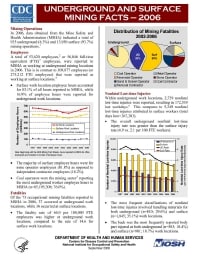Mining Publication: Underground and Surface Mining Facts - 2006
Original creation date: September 2008
Authors: National Institute for Occupational Safety and Health
NIOSHTIC2 Number: 20034782
Pittsburgh, PA: U.S. Department of Health and Human Services, Public Health Service, Centers for Disease Control and Prevention, National Institute for Occupational Safety and Health, DHHS (NIOSH) Publication 2008-166, 2008 Sep; :1-2
Mining Operations: In 2006, data obtained from the Mine Safety and Health Administration (MSHA) indicated a total of 935 underground (6.3%) and 13,950 surface (93.7%) mining operations. Employees: A total of 53,620 employees, or 56,046 full-time equivalent (FTE) employees, were reported to MSHA as working at underground mining locations in 2006. This is in contrast to 309,877 employees (or 275,212 FTE employees) that were reported as working at surface locations. Surface work location employee hours accounted for 83.1% of all hours reported to MSHA, while 16.9% of employee hours were reported for underground work locations. The majority of surface employee hours were for mine operator employees (81.8%) as opposed to independent contractor employees (18.2%). Coal operators were the mining sector reporting the most underground worker employee hours to MSHA (n=85,195,306; 76.0%). Fatalities: Of the 73 occupational mining fatalities reported to MSHA in 2006, 37 occurred at underground work locations, while 36 occurred at surface locations. The fatality rate of 66.0 per 100,000 FTE employees was higher at underground work locations, compared to the rate of 14.6 for surface work locations. Nonfatal Lost-time Injuries: Within underground work locations, 2,739 nonfatal lost-time injuries were reported, resulting in 172,539 lost workdays. This compares to 5,249 nonfatal lost-time injuries attributed to surface workers (total days lost=267,203). The overall underground nonfatal lost-time injury rate was greater than the surface injury rate (4.9 vs. 2.1 per 100 FTE workers). The most frequent classifications of nonfatal lost-time injuries involved handling materials for both underground (n=810; 29.6%) and surface (n=1,845; 35.1%) work locations. The back was the most frequently reported body part injured at both underground (n=503; 18.4%) and surface (n=981; 18.7%) work locations.

NIOSHTIC2 Number: 20034782
Pittsburgh, PA: U.S. Department of Health and Human Services, Public Health Service, Centers for Disease Control and Prevention, National Institute for Occupational Safety and Health, DHHS (NIOSH) Publication 2008-166, 2008 Sep; :1-2
- Coal and metal/nonmetal mining facts - 2008
- Coal and Metal/Nonmetal Mining Facts - 2008 (HTML)
- Coal Contractor Mining Facts - 2001
- Coal Contractor Mining Facts - 2002
- Coal Contractor Mining Facts - 2003
- Coal Contractor Mining Facts - 2004
- Coal Contractor Mining Facts - 2005
- Coal Contractor Mining Facts - 2006
- Mining Fact Sheets
- Rib Falls: A Major Ground Control Issue